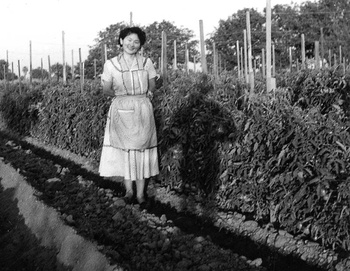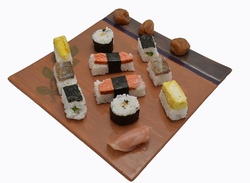I have been told by various people that I am a “good” cook. I’m usually able to put together dishes without recipes from whatever is in the refrigerator or to come up with menu ideas just walking down store aisles. Breakdown a chicken? Just give me the sharp cleaver. Need a grilled 20 pound Thanksgiving turkey instead of an oven roasted one? No problem. Need an easy appetizer for 20? Caramelized onion/pancetta quesadillas with guacamole. Sushi for six? Just let me start the rice. How exactly I learned to cook is partially a mystery to me. It might have been all the episodes of Galloping Gourmet I watched on PBS in the early 1970s…

My mother standing by some tomato plants on my parents first farm in Fresno, Calif. In the early 1950s. (Photo: Ben Arikawa)
Or maybe it was from watching my mother cook. Mom learned to cook in Japan, where she spent most of her first 26 years. She was born in California, but her father sent her to live with relatives in Japan when she was about 3 years old. She grew up in wartime Japan and was there until she married my father after the War. Much of the time, Mom cooked family style Japanese dishes for us. But, as the New Year approached, she would be busy preparing the holiday feast:
Cha shu (Chinese style barbeque pork)!
Chicken and beef teriyaki!
Onigiri (hand formed sushi rice balls)!
Maki sushi (sushi rice rolled in nori sheets)!
Inari zushi (sushi rice wrapped in deep fried tofu pouches)!
Tempura (lightly battered, deep fried vegetables, fish and shrimp)!
In the days before New Year’s, she went shopping for the ingredients: gallons of shoyu (soy sauce) and vinegar; bottles of mirin (a sweet Japanese cooking wine) or cooking sherry; large tin of Ajinomoto (monosodium glutamate); sugar; salt; fresh ginger roots; eggs; green onions, kamaboko (steamed fish cake); chicken; shrimp; pork; sheets of nori; aburage (deep fried tofu pouches); daikon and takuan (pickled daikon); rakkyo (small pickled white onions); kombu (dried seaweed used in making soup stock); and, of course, the short grain rice favored by the Japanese.
I remember sitting in my pajamas watching her start to work without recipes on the marinades. She would pull out some large pots. Out came the cutting board. Mom would thinly slice the ginger and garlic and add it to a pot with shoyu and sherry over a low heat. She would add sugar, salt, and the Ajinomoto. Once cooled, this mixture was the teriyaki marinade. In other pots she would make the marinade for the cha shu. She would expertly cut whole chickens into breasts, legs, and thighs. Every so often there would be a Whack! with her knife crunching through joints and bones. The chicken would then be slipped into the teriyaki marinade. The beef would be cut into thin strips, threaded onto bamboo skewers, and placed in the teriyaki marinade, too. She would carefully remove the excess fat while cutting the pork shoulder into thick strips and into the cha shu marinade they would go. The marinating meat might be left in the pots for several days unrefrigerated in a cool spot of the kitchen—something we would never consider doing now for fear of food poisoning. The sweet, salty, savory smell of sugar, shoyu, and sherry permeated the kitchen.
A day or two before New Year’s, Mom fired up our cast iron charcoal barbeque grill and spent hours cooking all the teriyaki and cha shu. She would watch it carefully, constantly worrying about getting too much of a char on the meat. We always hoped mom would make a few mistakes because we got to eat those first. The meat would be piled onto large plates to cool, typically unrefrigerated in a cool area of the kitchen.
As this was going on, one of us kids would help prepare the rice for the rice cooker. The rice, typically a short grain variety in a 50 pound bag, was measured, washed three times or until the water drained clear. We measured the amount of water for the rice cooker scientifically using our fingers. If the water came up to the first joint of our middle finger, that was the proper amount of water. Apparently this is a universal constant. The size of the pot doesn’t matter. The amount of rice doesn’t matter. The size of your hand doesn’t matter either.
Sushi making commenced. Mom made the su, the sushi vinegar, in a large pot gently warmed on the stove. Vinegar, Ajinomoto, mirin, salt, and sugar went into that pot. The rice would be dumped into a large wooden bowl. A certain amount of the su would be added to the rice while someone fanned the rice to keep too much of the su from evaporating. From this mound of flavored rice, all the various forms of sushi would be made. We would make hand-formed triangular onigiri, some with an umeboshi (salt-pickled plum) inside. Mom would roll maki sushi, filling them with strips of a fried egg omelet, kamaboko, takuan, cucumber, lightly marinated carrot, or green onions. Filling the aburage with rice for the inari zushi sometimes proved troublesome. Some pouches would tear and have to be discarded.
Very last to be cooked would be the seafood and tempura. Some of the shrimp with shell on was boiled in salted water. The shrimp to be cooked tempura style was to be butterflied and the dark vein removed. The vegetables were cut and set aside. Mom would mix the tempura batter from scratch, adding water or flour until she judged the consistency to be right. She would add a few ice cubes to keep the batter cold. Shrimp and vegetables went into the batter and then into the hot frying oil.
Presentation mattered. Mom carefully chose the placement of the food. Sushi, vegetables, teriyaki, cha shu, and tempura arranged on the plate for maximum visual effect. She made separate plates for relatives, friends, neighbors, and our workers. On these plates would be the best pieces of food. Of course, Mom made plates for our family, too. There was almost always more food than we could eat in several sittings, but nothing was wasted. Refrigerated, the teriyaki and cha shu might feed us for days. If the sushi rice became dry, Mom would put it into a steamer to warm and soften it. When all the food was gone, we had next year to look forward to.
As I finish writing this, I realize that I haven’t thought of these times in many years. Mom and Dad both have been gone for many years. And, nowadays, few families make their holiday meals from scratch. Most people would not want to take the time or effort to cook when it is so easy to run to the store and buy a prepared or prepackaged meal. But, there is something to a family cooking together, to children watching and learning to cook from their parents. If not passing on the traditions of food, at least passing on a love of food.
© 2012 Ben Arikawa







